Joel Coen wanted to do Macbeth. But not just any Macbeth, a black and white version inspired both by comic books and German Expressionism. The stars on screen for The Tragedy of Macbeth are Frances McDormand and Denzel Washington—but the stars in the lighting rig were ETC and High End Systems fixtures. The lighting team that put them there and used them to great effect was led by Gaffer Michael Bauman and Lighting Programmer David Kane. Here is a video on the making of The Tragedy of Macbeth. You can go to 3:01 in the video to hear from Cinematographer Bruno Delbonnel and Production Designer, Stefan Dechant on shooting the black and white film:
Bauman has been gaffing since the early ‘90s, moving from indie films and music videos to some of the biggest movies of all time, including the first two Iron Man films, Hunger Games: Catching Fire, Phantom Thread, and more. “It’s always interesting to see how different people approach similar lighting situations, different aesthetics,” he says, summing up his resume.”
He found himself in one of those interesting situations doing additional photography for the Coen Brothers’ project The Ballad of Buster Scruggs with cinematographer Bruno Delbonnel. “We had a great time. So, when he said, ‘Hey, we’re going to probably be doing this Macbeth thing that Joel’s directing. Would you be available?’ I was like, ‘Hell yes, of course!’”
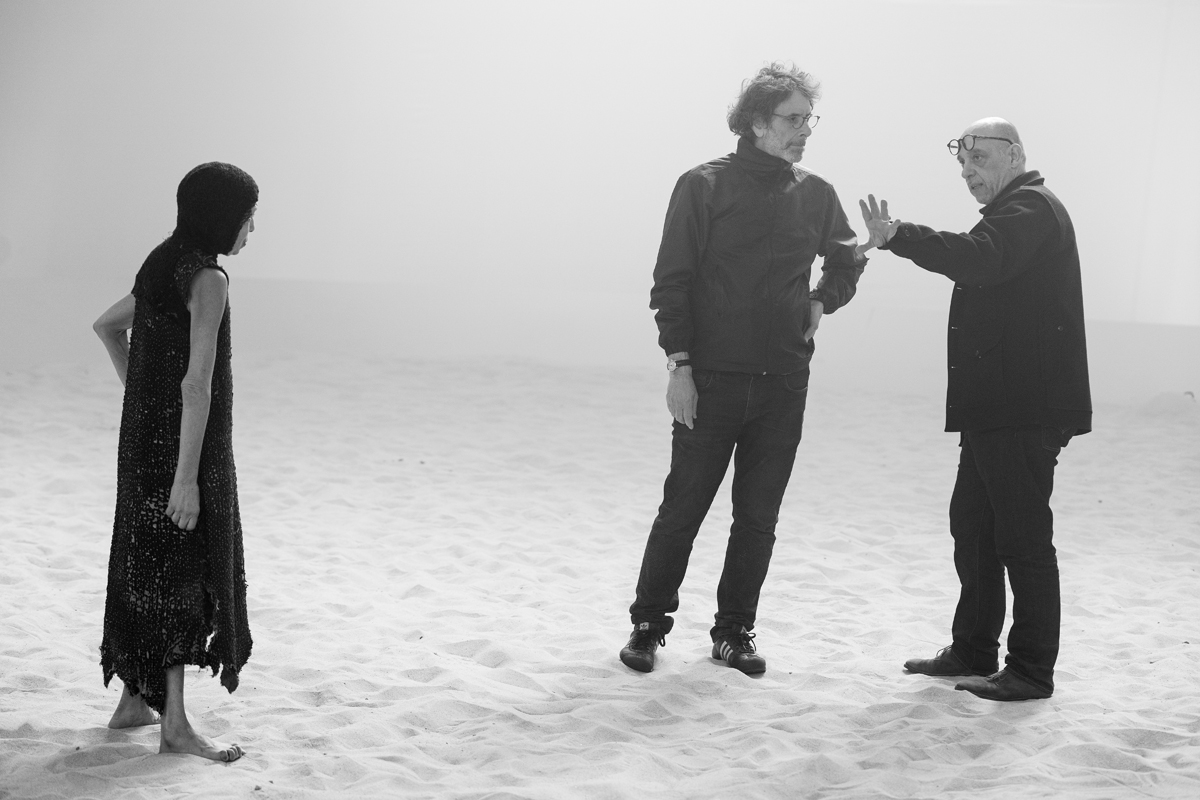
This is, of course, the only sane response to such an offer, and it was enthusiastically echoed by Lighting Programmer Kane when Bauman asked him to join the crew. “I have never agreed to do a job with Mike and been disappointed when I get there.” Kane has worked in film, narrative, variety television, and live events but knew this would be something special. “I think we all recognized it was a once in a career opportunity.”
The Look
The excitement—and expectations—only ramped up once they learned more about Joel and Bruno’s vision. The design brief called for a very theatrical, high-contrast look. “Think German expressionism, think Nosferatu, think lots of chiaroscuro. And keeping the set design very simple, like here’s two walls. Clean, sparse. Do the rest in lighting,” shares Bauman. “It was very high contrast, very sharp cuts. It was like a Frank Miller graphic novel—really extreme contrast levels. So, then you start thinking: What are the tools we are going to use to do this?”
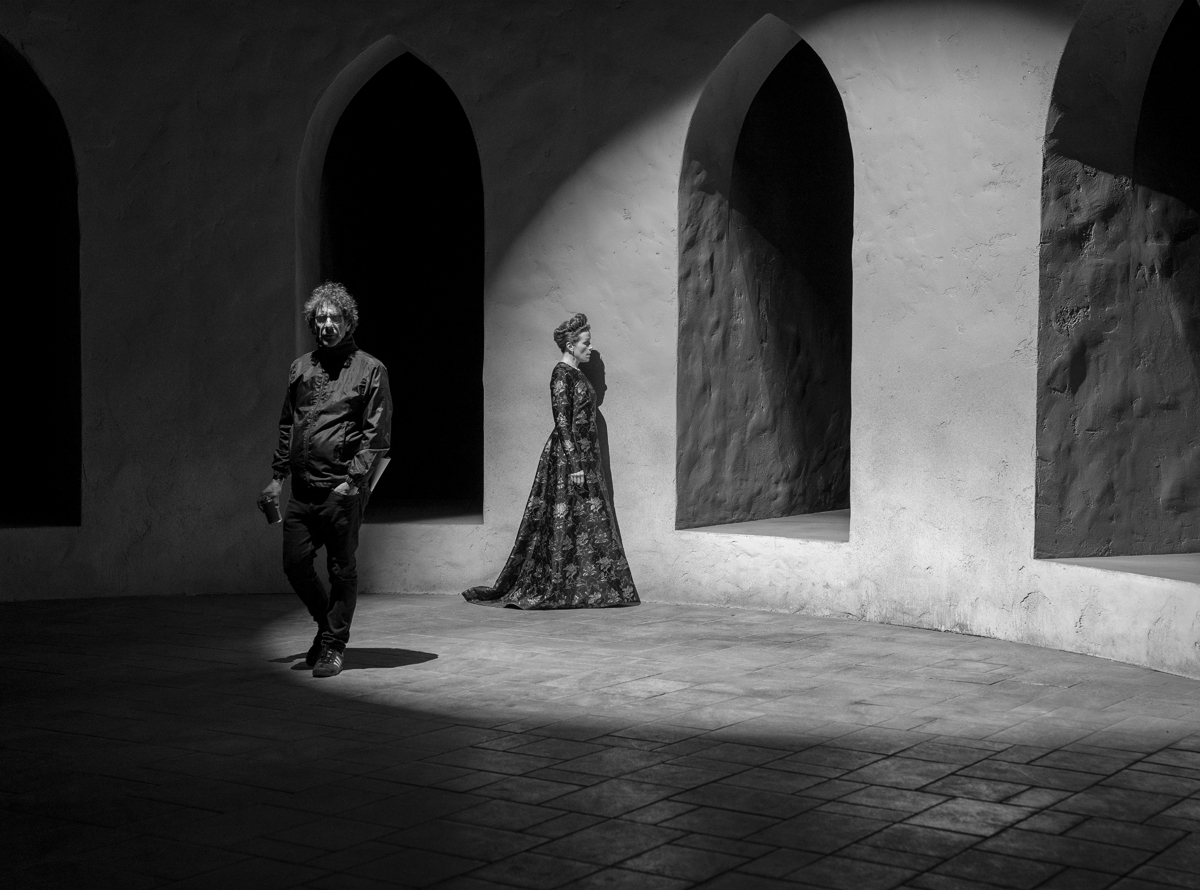
They did some test shooting, and it became clear very quickly that there was no way to do this with traditional film lighting using Fresnels and flags. “With all the green beds and support structure that you’d need, the cost of building the infrastructure to light in this traditional manner was going to be astronomical,” says Bauman. Cost also would have ballooned with the labor and time needed to set cuts and change lights for each take—and then wait for the lights to cooperate. “It would have been all about these very precise cuts and as soon as you get the look, don’t move anything and wait for the green beds to stop shaking.”
With all these problems, they decided to try moving lights. The difference was night and day. “We tested a lot of cues,” says Bauman, putting fixtures through their paces for light and color quality, movement, fades, focus, cuts—the whole gamut. “Spin that around, fade that out, bring that up, bounce those into the wall, bring in a slash here.”
Everyone walked away believers. “We wouldn’t been able to do what we wanted with traditional lighting. We would have had to put up a 20kW and then have 10 flags in front of it—that would have never, ever happened. So, the tests reassured us that, yes, we can go with this high contrast concept—if we used moving lights.”

Another nice feature about going with High End Systems automated fixtures was the versatility they added to the set. “We could populate the ceiling with movers and then use them a variety of different ways,” explains Bauman. “Maybe they were direct. Maybe they were a bounce. Maybe they were an ambient source. Maybe we created effects with them. They had a ton of versatility.”
Obviously being a film, they needed lights that were quiet. The High End Systems SolaFrame Studio and SolaFrame Theatre, with their rating of less than 20 dB(A) at 1 meter, were a perfect fit. “We started with as many SolaFrame Theatres as we could get. And then as many SolaFrame Studios as we could get, because the quantity of fixtures just blew up,” says Bauman. The production filled four sound stages with several hundred High End Systems fixtures.
“At one point we brought in a mover from another manufacturer that was arc-based, with an actual HMI lamp. It may as well have been a lawnmower on the set. I remember the sound crew asking, ‘What the $&*# is that?’ The need for minimal—and I mean minimal—background noise was critical for this production.”
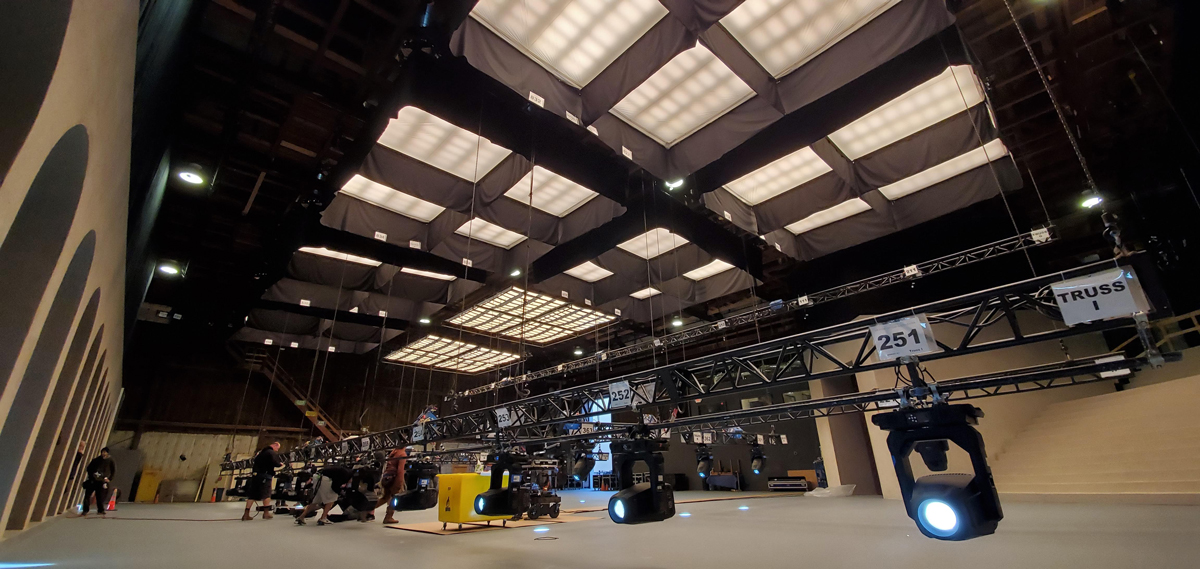
The SolaFrame fixtures’ silence and versatility didn’t just help the sound op. They were crucial to the performances as well. “Shakespearian dialogue is not easy,” says Bauman. He saw the care and craft Denzel Washington and Frances McDormand would put into getting into character and staying present in a scene, and knew his lights had to help them give the best performance they could. “When they were in the zone and they were performing, the fact that we could make adjustments without even having to go into the space and interrupt their process was critical. Can you imagine going into the set and being like, ‘Take that cut down there. Let’s move this over here. Oh, that doesn’t work. Go back.’” Bauman laughs at the idea. “That would have totally interrupted the creative flow that was going on. There is no way we could’ve lit this as well if we had been doing it with traditional lighting.”
Even though the film was black and white, the color capabilities of the fixture were still important, influencing not just shades of black and white, but also affecting depth and perspective. “Our eye looks for color to create depth and in the absence of that, especially in photography, you have to come up with other ways of creating separation and depth. You figure out ways through color and tonality to create depth—even if it ends up in black and white,” explains Bauman.
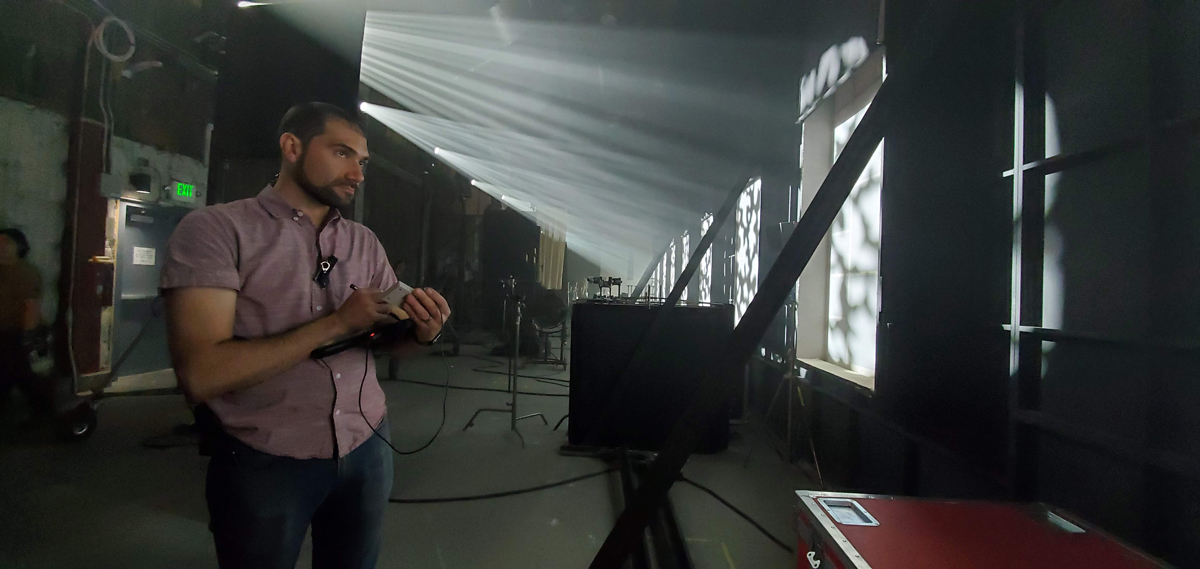
The High End Systems SolaFrame’s animated gobo wheels also played a part in the overall look. Sometimes subtle (clouds passing over a character’s face) or sometimes obvious (creating shadows on walls) they added a movement and texture to light that the cinematographer was looking for. “We ended up creating a bunch of custom gobos to go in the various High-End fixtures,” says Kane. “On set, the SolaFrame Theatre, SolaFrame 3000, and SolaHyBeam 3000 fixtures were the meat and potatoes of the film. They gave us the tools where we needed them to give Bruno the flexibility on the day to be creative.”
Some of that creativity was very soft, very slowly moving patterns, just out of focus. Or subtle patterns projected on actor’s faces. “In some very dramatic scenes, we’re just doing soft movements on the actors faces to create the movement of clouds in the sky or the waving of the sheets in Lady Macbeth’s bedroom,” Kane continues. “I’ve never been asked to do that before—you couldn’t do it with static fixtures—but it worked really well.”
The Collaboration
I don’t know how much you know about Hollywood, but black and white, period films using original Shakespearean English generally do not make as much money as a superhero movie—even with stars the caliber of Frances McDormand and Denzel Washington acting and Joel Coen directing. Add in a Covid-mandated break from production, and you can understand why the process of filming had to be as fast and smooth as possible to save as much money as possible.
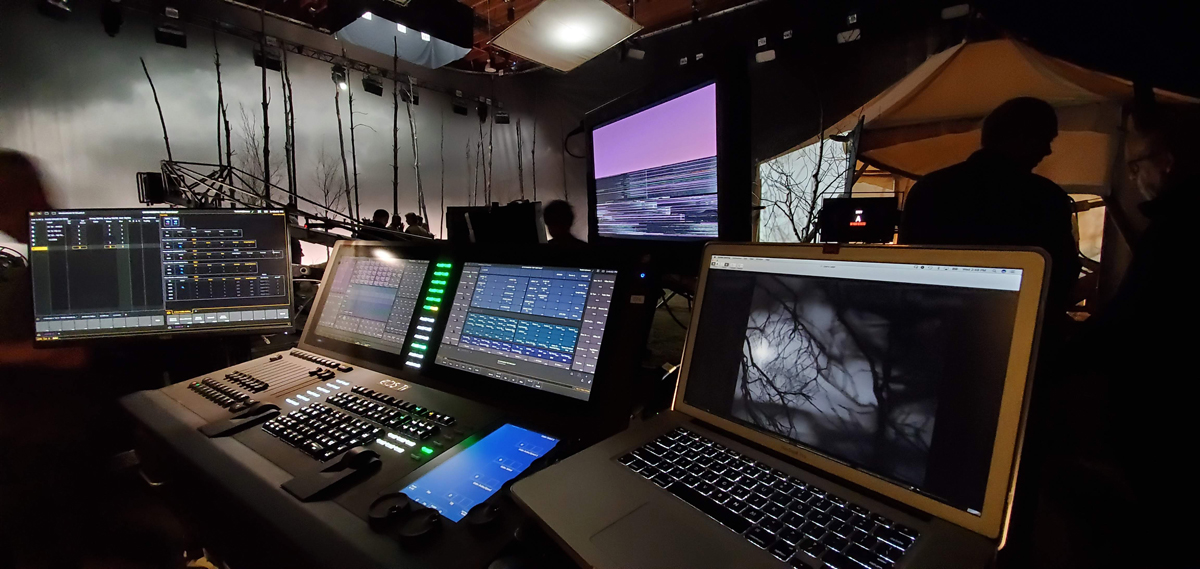
ETC’s programming tools made it easy Kane to adjust on the fly and give everybody new looks and new options in the moment, at the speed the crew needed to be productive and creative. “Picking the correct programmer is going to be the difference between real true success and getting it done,” says Bauman. “David could really understand Bruno’s thoughts. Even with the speed on set he fully meshed up with how Bruno’s creative process was.”
“Bruno and Joel’s vision was very clear,” says Kane “We gave ourselves the tools to be flexible on the day and to really be creative.” Those tools included 2 ETC Eos Ti consoles, a Gio @5 console, and four ETC Eos Remote Processor Units in addition to a Surface Pro running ETCnomad software for wireless tablet control on set. With Nomad and the console synced up, Kane had access to all his tools from anywhere on set. “There are many times where we would be in these tight interiors—at the end of a long hallway or crammed into Lady Macbeth’s bedroom—or in the middle of a vast set, and I would be able to adjust the look on the fly in the middle of it. It would just be the three of us and we would finesse a look. ‘Oh, you know what, let me just grab this fixture and bring the shutter in just a little bit. Let me fuzz it out, just a hair.’ You can have a very organic relationship with your collaborators without being stuck at the lighting desk. It was like having a direct relationship with the lights.”
With Eos’ flexibility and capabilities, the filmmakers were able to iterate quickly between three or four ideas before settling on a final look. “That’s not necessarily something you can do with, with just standard hot lights and people up in lifts focusing,” says Bauman. “There’s so much time investment in using a static focus light that you can kind of get stuck with a focus because you’ve invested 10 or 15 minutes into adjusting that fixture. Whereas here, using the moving fixtures, we could very easily try four or five different things if we wanted to in the time it would take for one person to get up to a light and change it.”
The Coronation
How often do you get asked to make art for art’s sake? In Hollywood of all places? “We recognized every day how lucky we were to be working on that film,” says Kane. “Everyone who had a hand in this project realized how special it was and that doesn’t come around very often, so I think a lot of us treated it with great care.”
High End Systems fixtures and ETC controls were instrumental to creating an amazing look for a film that is garnering a lot of awards buzz—and rightly so. “Macbeth was one of those projects where every day you came home and you feel like you contributed to something substantial, something that is going to be part of the language of cinema,” says Kane.
And if the team has anything to say about it, movers will be a part of making cinema moving forward. Bauman shares a story from early in the shoot. After one week on set, Bauman relates, “Bruno said, ‘There’s no other way we could do this movie. This is fantastic.’ And that’s because thanks to the High End Systems fixtures we could give him so many creative options. It really made it easy for everybody.”
Further information from ETC: etcconnect.com


